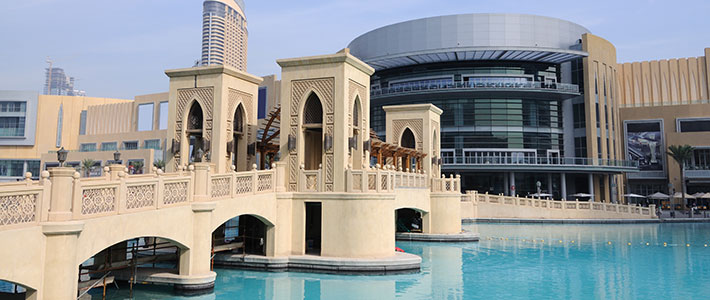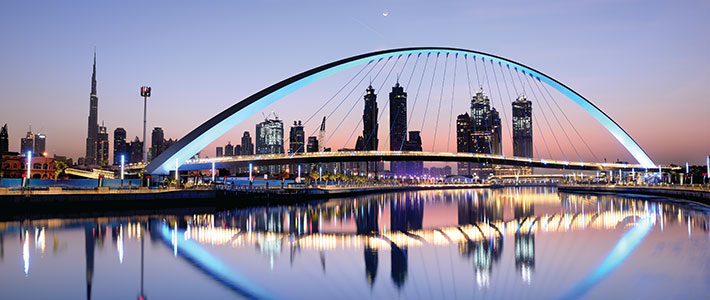
Dubai is the jewel among the seven United Arab Emirates – a once-desert sheikdom that has become one of the most popular tourist destinations in the region.
As well as the modern skyscrapers like the Burj Khalifa and football-stadium-sized shopping malls, theme parks and indoor ski slopes, Dubai offers visitors a rich cultural experience in the historic Bastakia district and dhow cruises along Dubai Creek. Dubai’s restaurant scene is world-class and the city is a renowned artistic hub with regular international art fairs and exhibitions.
Top five must-see sights and attractions
The Dubai Mall

The Dubai Mall boasts over 1,000 shops and restaurants, and is one of the most popular Dubai attractions, especially during the intense summer heat.
Most malls in Dubai have become entertainment complexes and Dubai Mall is no exception. You can skate here at the Dubai Ice Rink, catch a movie at the multiplex, visit Kidzania theme park, and Dubai Aquarium & Underwater Zoo. Dubai Mall is a hive of activity during January and February’s Dubai Shopping Festival.
Burj Khalifa
The most iconic landmark in Dubai, the 829.8m Burj Khalifa is the tallest building in the world and offers visitors incredible 360-degree views over the city from its 124th floor observation deck. Nighttime viewing is spectacular when you can see over both the city skyscrapers, the desert and the ocean.
Start your ascent on the ground floor with a look at the interactive displays charting the history of the tower, then head to the elevator. Traveling at more than 10m per second you’ll be at the top in less than a minute. Stop for lunch or dinner at the At.Mosphere restaurant on the 122nd floor before descending and taking a walk around the Burj Khalifa’s gardens – don’t miss the Dubai performing Fountain. The world’s tallest, they were designed to look like the Bellagio fountains in Vegas.
Dubai Creek and Al Seef District
Dubai city is divided into two areas, bisected by Dubai Creek. In the south is Bur Dubai and to the north Deira. Original settlers here were pearl fisherman and the region has been inhabited for at least 4,000 years.
Visit the Dhow Wharf area just north of Al-Maktoum bridge – these historic boats are still being used to transport goods after more than 100 years of service – and visitors are allowed on board for a tour before the boats head down to the Horn of Africa and back.
The waterfront at Bur Dubai has undergone significant regeneration resulting in the creation of the new Al Seef District with its appealing promenade, craft shops and floating market. To cross the creek take a restored dhow or jump on board one of the abra (wooden ferries).
Bastakia (Old Dubai)
Al Fahadi Historical District – known by locals as Bastakia – is a living reminder of life in the region before the foundation of the UAE. Back then Dubai was just a sleepy fishing town on Dubai Creek (Khor Dubai), Bedouins roamed the area fishing, herding goats and growing dates.
The Bastakia district along this creek is fascinating and well worth a day trip. Founded in the late 19th century, the region is a warren of well-preserved dwellings made from coral and limestone. Wander among the galleries and tea rooms and don’t miss the Al Serkal Cultural Foundation which has regular exhibitions as well as shops and a café.
Deira
Just north of Dubai Creek lies Deira, the most multicultural district in Dubai combining ancient and modern with its skyscraper backdrop against historic dhow sailing ships. Deira is best known for its various souks which attract many locals as well as tourists.
The Gold Souk is widely regarded as the largest gold marketplace on earth, while the Spice Souk sells all manner of spices such as frankincense, saffron as well as rose water and incense. The adjacent fish market is far less aromatic but an interesting experience, nonetheless.
Two restored buildings in Deira worth visiting are Heritage House and the Al-Ahmadiya School – the oldest school in Dubai built in 1912.
Best time to visit

Dubai is a desert city so expect high temperatures throughout the year. The best time to visit Dubai is from November to April during the winter months. The weather is hot but manageable and outdoor activities are much more pleasurable.
In January and February the city plays host to the popular Dubai Shopping Festival – peak season in the city. By April and May the heat is very noticeable and by summer the intensity (40 degrees Celsius plus) combined with the humidity, makes walking outside almost impossible. In summer, most activity in Dubai is centered indoors in the air-conditioned malls, cinemas and entertainment complexes.
Getting around
Once in Dubai you’ll need a car to get around. Either collect your rental car from the airport or use Uber or regular taxis – the latter is the best option at night. If the cab light is yellow it’s available. If occupied then the light is red. Only a few areas of Dubai are suitable to explore on foot, including: City Walk, Dubai Marina, the Bur Dubai historic area and Deira.
Final call
Dubai offers visitors an incredible year-round holiday experience with stunning landscapes, luxury shopping as well as many attractions and superb beaches to enjoy. Let us arrange you private jet charter travel to and from Dubai.